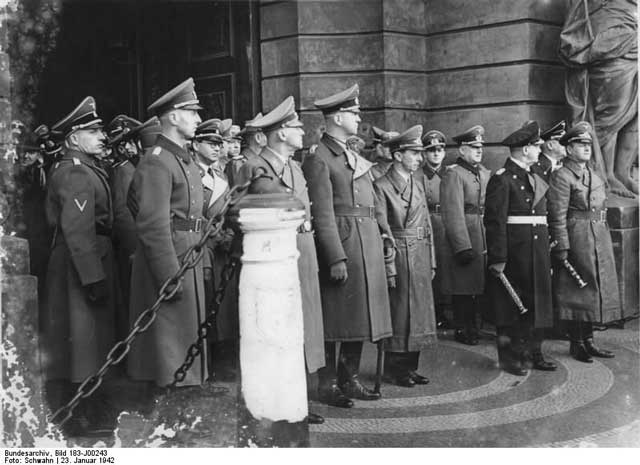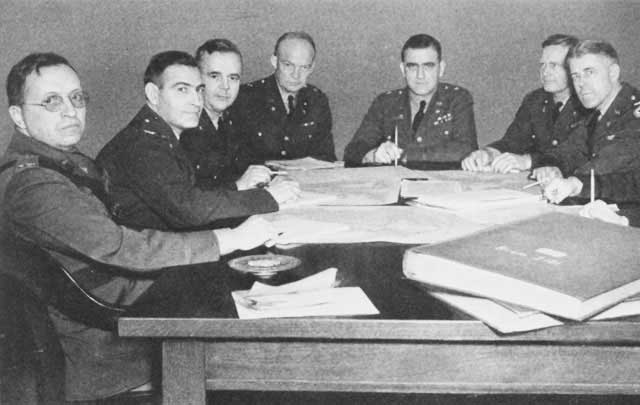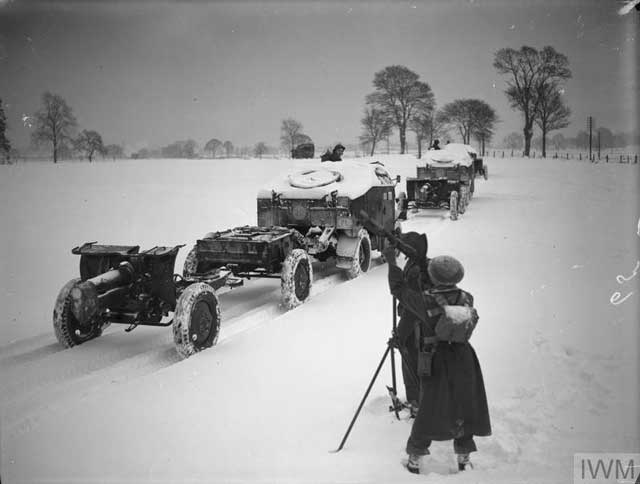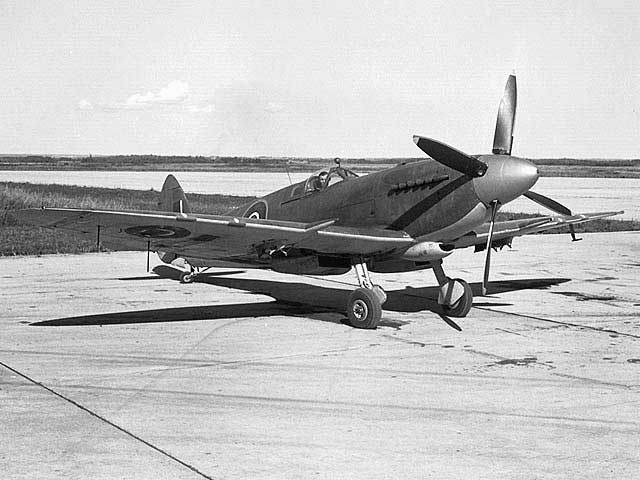Tuesday 27 January 1942
 |
| "Flight Lieutenant Tadeusz Czerwiński, the CO of "A" Flight of No. 306 Polish Fighter Squadron, and Flight Lieutenant Stanisław Skalski, the CO of "B" Flight, with the Polish national emblem. RAF Churchstanton, 26-28 January 1942." Colorized from © IWM (CH 4793). |
Battle of the Pacific: The Battle of Endau has been a disaster for the British both on land and in the air, but on 27 January 1942 they attempt to turn the tide at sea. Rear-Admiral Ernest Spooner, commander of naval forces at Singapore, has sent his only combat-ready warships, destroyers HMS Thanet and HMAS Vampire, to attack the Japanese invasion fleet off Endau. However, while the landings and related air battles resolved the situation during daylight hours on 26 January, the Royal Navy ships do not arrive until the early morning hours of 27 January.
Commander William Moran, captain of destroyer Vampire, is the overall commander of the small force, which also includes destroyer Thanet (Commander Bernard Davies). The British figure the forces are roughly equal and that surprise at night will give them an advantage. The Japanese, meanwhile, have received erroneous reconnaissance reports of British ships operating to their north and thus shift their escorts in that direction, away from the approaching Royal Navy destroyers. The British could have mounted a much stronger effort if they still had battleship Prince of Wales and cruiser Repulse available, but those ships, of course, were sunk in December 1941.
The two Royal Navy destroyers approach undetected and pass at least one Japanese ship without being spotted. At 02:37, Vampire firest two torpedoes at Japanese minesweeper W-4 but misses with both. Inexplicably, W-4's crew spots but does not report the two destroyers, and the British are free to continue searching for the Japanese transports. While this search is unsuccessful, at 03:18, the British spot and attack Japanese destroyer Shirayuki. However, despite launching a total of five torpedoes, the two British destroyers make no hits. Shirayuki spots the British but is unsure if they are friend or foe. After a period of indecision, Shirayuki opens fire at 03:31. Commander Moran returns fire but also orders both ships to withdraw. Destroyers Thanet and Shirayuki both sustain hits and are put out of action, but other Japanese ships quickly close. Destroyer Vampire makes its escape undamaged and reaches Singapore at 10:00, but Japanese ships Sendai, Fubuki, Asagiri, Amagiri, Hatsuyuki, and W-1 close on the immobile Thanet and sink it at 04:18.
Destroyer Shirayuki rescues 31 men from Thanet, while 12 British sailors perish in the battle itself. Commander Davies and 65 other men manage to swim to shore and make it back to Singapore. The "rescued" British sailors are never seen again and are presumed to have been executed by the Japanese out of spite, contrary to the rules of war. The Japanese landings continue without interference. The British failures at the Battle of Endau are probably the most significant single event leading to the evacuation of Johore and the ultimate fall of Singapore. Commander Moran submits a report on the battle, however, in which - despite the loss of Thanet - he stresses how poorly the Japanese reacted to his attack. This gives the Allied navies a false sense of confidence which is greatly misplaced.
On the Malay Peninsula, the battle is rolling south toward Johore Bahru. The War Diary states that the Australian defenders holding the outer line at the Luo Tye Estate have made a "clean break" from the Japanese. Withdrawals are taking place efficiently and quickly. However, Indian troops fighting on the outskirts of Johore itself take heavy losses, including the death of their commanding officer, Major-General A.E. Barstow.
In Singapore, Lieutenant General Arthur Percival, General Officer Commanding Malaya Command, sees the writing on the wall from the lost Battle of Endau. He requests and receives permission from General Archibald Wavell for the complete abandonment of the mainland. Percival immediately orders a general withdrawal through Johore Bahru and across the causeway to Singapore Island. This withdrawal is scheduled for the night of 30/31 January. There is one piece of good news for the defense of Singapore - the civilian workers who have refused to work on fortifications on the island's vulnerable north shore finally reach terms on a salary that they will accept and get to work. The British remain under the illusion that Singapore Island can hold out by itself without retaining a foothold on the mainland.
In the Philippines, the Japanese launch a major assault against the Allied Main Line of Resistance (MLR) during the afternoon. The Japanese make quick gains into the MLR and secure a bridgehead across the Pilar River. The Allies in the western I Corp section have the most success in stopping the attack. However, they still have the annoyance of the Japanese landing far behind the MLR at Quinauan Point and Longoskawayan Point. Lieutenant General Jonathan Wainwright, Commanding General I Corps, sends troops from the 45th Infantry Regiment of the Philippine Scouts to attack the former and troops from the 57th Infantry Regiment of the Scouts to attack the latter. A fierce battle develops, but despite being backed up within 1000 yards of the beach, the Japanese continue to hold out. The Japanese successfully land a relief force north of the trapped Japanese, and the defending 1st Battalion of the 1st Philippine Constabulary quickly gives up. Thus, the Allied defenders are fighting two separate battles in opposite directions and are unable to win either of them.
In Borneo, the Japanese continue expanding their hold. They take Ledo, Pemangkat, Sambas with its Naval Air Station, Singkawang, and Singkawang II airfield. Sinkawang is a small city on the northwestern coast of about 145 km north of the regional capital Pontianak. While not of much economic importance, Sinkawang is in a militarily useful location. Singkawang also is a regional center for Roman Catholic missionaries who maintain the "Apostolic Vicariate of Dutch Borneo," which includes a leprosy colony.
US Navy submarine USS Gudgeon (Lt. Cmdr. Elton W. "Joe" Grenfell), on its first war patrol, is returning to base from the first patrol by a US submarine along the Japanese coast when it spots a target. Grenfell fires three torpedoes and sinks Japanese submarine I-73 about 240 miles west of Midway Atoll. This is the first victory by a US submarine against an enemy warship (as opposed to an enemy freighter, already accomplished). Grenfell thinks that he has only damaged I-73, but Station HYPO (also known as Fleet Radio Unit Pacific (FRUPAC) intercepts and decodes Japanese fleet signals admitting the loss. So, Grenfell and the Gudgeon's crew have a welcome surprise in store for them when they return to Pearl Harbor.
The Gudgeon's victory is important for a much more important reason than just the sinking of one ship. Its torpedoes contain RDX/Torpex (RDX stands for Research Department Explosive), a powerful new explosive that is twice as powerful as TNT. Some people believe that RDX/Torpex is a major reason why the Allies win World War II, as it ultimately is used in a wide variety of munitions including air bombs, torpedoes, C-4 plastic explosives, anti-submarine "hedgehog" weapons, and even the trigger for the atom bomb "Fat Man" dropped on Nagasaki. Gudgeon's success proves the usefulness in combat conditions of this deadly substance.
Battle of the Atlantic: The British Admiralty finally admits the loss of HMS Barham, sunk in the Mediterranean on 25 November 1941. It explains the lengthy delay by stating that "it was important to make certain dispositions before the loss of this ship was made public." Dramatic footage of this sinking by Pathé News, filmed aboard Barham's sister ship HMS Valiant, eventually is shown on the newsreels. It shows Barham still covered with men when it blew up. There were 862 deaths on Barham, including Vice-Admiral Henry Pridham-Wippell, and 487 survivors. The Germans, who now have official British confirmation of the loss, quickly award U-331's captain, Oblt. Tiesenhausen, the Knight's Cross of the Iron Cross today.
Eastern Front: The Red Army has a tremendous opportunity to destroy the German Army Group North on 27 January 1942. A major battle is brewing around Vyazma, on the main highway between Smolensk and Moscow. Through a series of operations, the Red Army has parachute troops south of Vyazma, General Yefremov's 33rd Army is approaching along the highway from the east, and XI Cavalry Corps has reached the highway fifteen miles west of Vyazma. The highway serves as the main supply route for German forces west of Moscow, and the German guards and drivers of the trucks bringing food and ammunition east have to fight off attacks. Nowhere except in the east do the Soviets have enough strength to truly the German forces in Vyazma, but they can isolate it. The German supply difficulties are compounded by the lack of trains and train crews able to run on the railway line just south of the highway. Because the rail lines are of a different gauge than the German rail system, Soviet trains must be run, and only Russian train crews can keep them running. Both are in short supply.
Hauptmann Wilhelm Spies, Staffelkapitän of the 1./ Zerstörergeschwader 26 "Horst Wessel," a 20-victory ace with over 300 sorties flown, is shot down and killed. He is shot down by anti-aircraft fire near Sukhinichi (Suchinitschi), Russia. A rare Luftwaffe ace whose victories were evenly divided between the Eastern and Western Fronts, Spies holds the Ritterkreuz at the time of his death and is posthumously promoted to Major and awarded the Oak Leaves to his Knight's Cross. Losses of experienced pilots like Spies are difficult for the Luftwaffe to make good because he developed a wealth of combat experience beginning in the Spanish Civil War and continuing through all of the subsequent major campaigns.
Partisans: German Fourth Army has been fighting desperately to keep its lifelines, the Rollbahn highway and nearby railway line running northeast from Roslavl to Yukhnov, open for two weeks. The difficulty for the Germans is that these lines run parallel to the front, meaning the understrength Wehrmacht units in the area have to defend the entire length. Both sides have brought up reinforcements in bitterly cold weather, and General Gotthard Heinrici, the 43 Corps commander who took over Fourth Army from General Ludwig Kübler on 21 January, has had some success. The Germans have kept their supply line open most of the time by turning every journey along the road and highway basically into a naval convoy using armored trains and troop escorts (or, to use another analogy, into a wagon train escorted by the US Cavalry in the Old West). The defense of the Rollbahn and the rail line, however, has come at the expense of giving up large areas behind them to partisans. On 27 January 1942, the Soviets complete a large movement across the Rollbahn by the Red Army's I Guards Cavalry Corps under General Nikolay Belov. The Rollbahn and railway are closed on 27 January due to Belov's activity, but the Germans have sufficient forces nearby to reopen it in a few days when absolutely necessary.
Belov has no intention of trying to cut the German railway line and highway permanently and invite a desperate counterattack. Instead, once across them, he turns north to make contact with partisan units operating near Vyazma. It is a curious maneuver, as regular army units generally do not operate as partisans, but the front at this point is so confused that nobody is really sure where it is anyway. Belov also hopes to make contact with IV Airborne Corps, which has dropped southwest of Vyazma but accomplished little. The overall Red Army plan is to take Vyazma and cut the highway to Moscow which runs through there. These complicated Soviet plans pose a great risk to the Germans but in some ways also help them. Because the Germans are having difficulty keeping their supply lines open south of Vyazma, Belov probably has enough strength to shut them permanently - which might be enough to strangle German Fourth Army. As it is, though, by heading north into the middle of forests and open fields, Belov gives the Germans the time they need to reorient their forces and bring in reinforcements from the west. This may enable the German Fourth Army to survive. Spring is coming closer every day, so every day that it survives gives Fourth Army more hope. However, if the Red Army can take Vyazma, it would encircle Army Group North and compel a general German withdrawal.
German/Italian Relations: Hermann Goering is in Italy on Hitler's request that he "straighten out" the situation down there. Goering is considered the Reich's prime expert on Italy (because he visited it in the 1920s while virtually penniless) and considers it his personal domain (as opposed to other allies and occupied nations where Foreign Minister Ribbentrop represents Germany). However, Goering makes a poor impression upon this critical ally. Goering completely ignores Italian Foreign Minister Count Ciano, who makes disparaging remarks in his personal diary about the Reichsmarschall. "In fact, ever since we bestowed that [diamond] collar on Ribbentrop, [Goering] has adopted an aloof air toward me," Ciano spitefully writes, referencing a story about Goering playing with jewels on the train ride over the Alps.
Goering is unusually candid with Mussolini about the turn of the war on the Eastern Front. He admits at the train station that "We are having a hard time." Today, however, Goering strikes an air of bravado at a formal meeting, saying:
British Government: Prime Minister Winston Churchill makes a lengthy address on the war situation to the House of Commons. The gist of his message is that Operation Crusader in Libya was a success:
American Homefront: President Roosevelt announces rationing of all consumer goods and commodities until the war is won. It will be administered by the Office of Price Administration (OPA) using rationing books.
1942
January 1942
January 1, 1942: Declaration By United Nations
January 2, 1941: Manila Falls to Japan
January 3, 1942: ABDA Command Announced
January 4, 1942: MacArthur on His Own in the Philippines
January 5, 1942: Soviets Plan General Offensive
January 6, 1942: US Army in Europe
January 7, 1942: Soviet General Offensive Opens
January 8, 1942: Hitler Sacks Hoepner
January 9, 1942: Battle of Dražgoše
January 10, 1942: Building the Jeep
January 11, 1942: Japan Takes Kuala Lumpur
January 12, 1941: Rommel Plans Counterattack
January 13, 1942: First Ejection Seat Use
January 14, 1942: Operation Drumbeat First Sinking
January 15, 1942: U-Boat Off NYC
January 16, 1942: Carole Lombard Crash
January 17, 1942: British Take Halfaya Pass
January 18, 1942: Soviet Paratroopers in Action
January 19, 1942: FDR Approves Atomic Bomb
January 20, 1942: The Wannsee Conference
January 21, 1942: Parit Sulong Bridge Battle
January 22, 1942: Parit Sulong Massacre
January 23, 1942: Japan Takes Rabaul
January 24, 1942: Battle of Makassar Strait
January 25, 1942: Kholm Surrounded
January 26, 1942: GIs Land in Europe
January 27, 1942: Battle of Endau
January 28, 1942: Rommel Takes Benghazi
January 29, 1942: First US Coast Guard Ship Sunk
January 30, 1942: Singapore Isolated
January 31, 1942: Army Group South Averts Disaster
2020
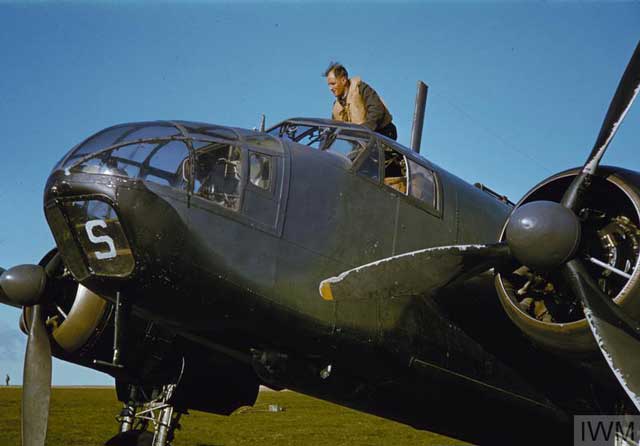 |
| A rare original color photograph from World War II. "A pilot, thought to be Flight Lieutenant A J H Finch, DFC, is about to settle into the cockpit of Bristol Beaufort I N102/'MW-S' of No 217 Squadron, Royal Air Force prior to flying for photographers at St Eval, Cornwall." © IWM (TR 25). |
 |
| Look magazine, 27 January 1942. |
 |
| "Commander in Chief Rosyth, Vice Admiral Sir C. Gordon Ramsey, KCB. 27 January 1942, Rosyth." © IWM (A 7246). |
 |
| Female metal workers in Leningrad, January 1942. Tank construction continued in Leningrad throughout the siege, sometimes with factories in sight of the front. |
In Singapore, Lieutenant General Arthur Percival, General Officer Commanding Malaya Command, sees the writing on the wall from the lost Battle of Endau. He requests and receives permission from General Archibald Wavell for the complete abandonment of the mainland. Percival immediately orders a general withdrawal through Johore Bahru and across the causeway to Singapore Island. This withdrawal is scheduled for the night of 30/31 January. There is one piece of good news for the defense of Singapore - the civilian workers who have refused to work on fortifications on the island's vulnerable north shore finally reach terms on a salary that they will accept and get to work. The British remain under the illusion that Singapore Island can hold out by itself without retaining a foothold on the mainland.
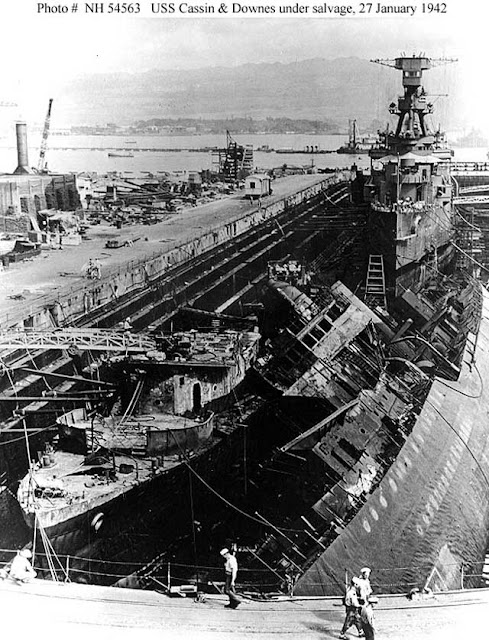 |
| USS Cassin (at right, DD-372) and Downes (DD-375). "Under salvage in Drydock Number One at the Pearl Harbor Navy Yard, 27 January 1942. They had been wrecked during the 7 December 1941 Japanese air raid." U.S. Naval Historical Center Photograph Photo #: NH 54563. |
 |
| A photo from Luftwaffe magazine Der Adler, 27 January 1942, showing pilots who are training using gliders. |
 |
| "British Troops disembarking from tugs and lighters at Malta." Malta, 27 January 1942. © IWM (A 7325). |
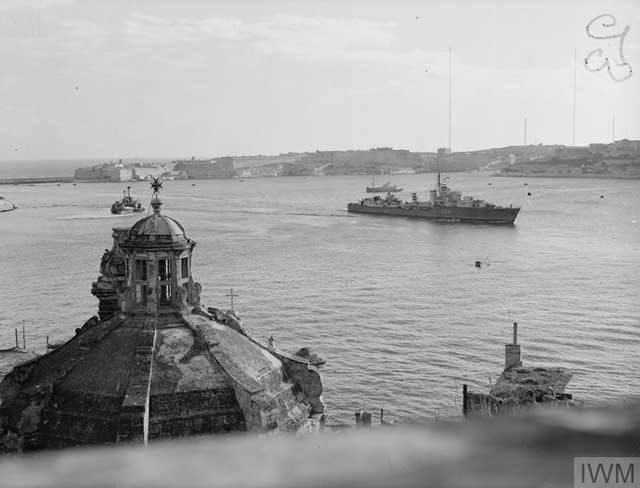 |
| "HMS MAORI entering Grand Harbour." Malta, 27 January 1942. © IWM (A 7333). |
 |
| HMS Barham rolls over and explodes. |
 |
| "German Beauftragte [Plenipotentiary] orders the Kyiv City Administration to Allow a Ukrainian Woman to Purchase Furniture Owned by Jews, 27 January 1942." (EHRI Online Course in Holocaust Studies) |
 |
| Wilhelm Spies, pointing to his 19th (of an ultimate 20) victory marking. |
 |
| A WAAF of the RNZAF, Hobsonville, January 1942. She is sitting in what appears to be a Harvard trainer (Whites Aviation Collection, Alexander Turnbull Library). |
 |
| Luftwaffe ace Wilhelm Spies, KIA 27 January 1942. |
 |
| The Belfast Telegraph, 27 January 1942. This announces the first arrival of units of the US Army in the European Theater at Belfast - on page two. |
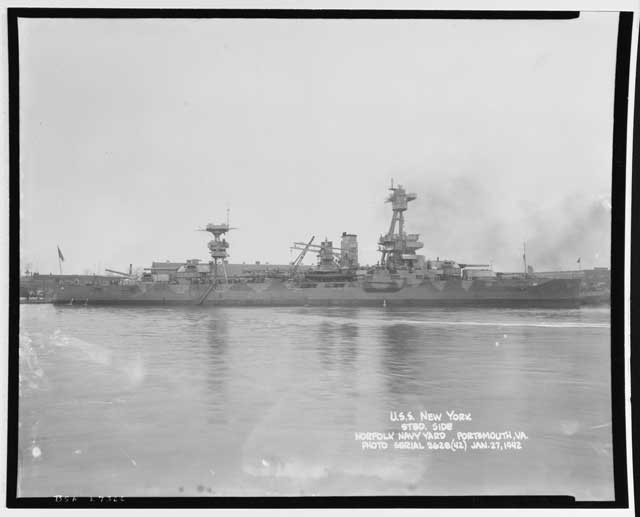 |
| New York on 27 January 1942, Norfolk Navy Yard. (U.S. Navy Bureau of Ships Photograph 19-N-27366, National Archives and Records Administration, Still Pictures Division, College Park, Md.). |
Such difficulties [relating to the bitter winter] will not recur. Whatever happens in the coming year, the Fuehrer will halt and take up winter quarters in good time.The main subject of the discussions, which last until 5 February, is the issue of getting supplies to General Erwin Rommel's Afrika Korps in Libya. Goering loftily suggests that Italian submarines make the supply missions, though they are almost all committed in the Atlantic and cannot possibly carry enough supplies.
 |
| "HMS BRECONSHIRE entering Grand Harbour, Malta." 27 January 1942. © IWM (A 7330). |
Whether you call it a victory or not, it must be dubbed up to the present, although I will not make any promises, a highly profitable transaction, and certainly is an episode of war most glorious to the British, South African, New Zealand, Indian, Free French and Polish soldiers, sailors and airmen who have played their part in it.Churchill, of course, knows that the tide already has turned in North Africa (there are no operations today due to a sandstorm) and that General Rommel once again is on the offensive. However, this is a well-earned victory speech, if a bit tardy and outdated.
American Homefront: President Roosevelt announces rationing of all consumer goods and commodities until the war is won. It will be administered by the Office of Price Administration (OPA) using rationing books.
1942
January 1942
January 1, 1942: Declaration By United Nations
January 2, 1941: Manila Falls to Japan
January 3, 1942: ABDA Command Announced
January 4, 1942: MacArthur on His Own in the Philippines
January 5, 1942: Soviets Plan General Offensive
January 6, 1942: US Army in Europe
January 7, 1942: Soviet General Offensive Opens
January 8, 1942: Hitler Sacks Hoepner
January 9, 1942: Battle of Dražgoše
January 10, 1942: Building the Jeep
January 11, 1942: Japan Takes Kuala Lumpur
January 12, 1941: Rommel Plans Counterattack
January 13, 1942: First Ejection Seat Use
January 14, 1942: Operation Drumbeat First Sinking
January 15, 1942: U-Boat Off NYC
January 16, 1942: Carole Lombard Crash
January 17, 1942: British Take Halfaya Pass
January 18, 1942: Soviet Paratroopers in Action
January 19, 1942: FDR Approves Atomic Bomb
January 20, 1942: The Wannsee Conference
January 21, 1942: Parit Sulong Bridge Battle
January 22, 1942: Parit Sulong Massacre
January 23, 1942: Japan Takes Rabaul
January 24, 1942: Battle of Makassar Strait
January 25, 1942: Kholm Surrounded
January 26, 1942: GIs Land in Europe
January 27, 1942: Battle of Endau
January 28, 1942: Rommel Takes Benghazi
January 29, 1942: First US Coast Guard Ship Sunk
January 30, 1942: Singapore Isolated
January 31, 1942: Army Group South Averts Disaster
2020
